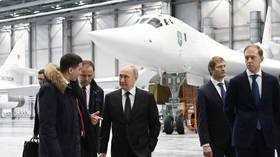Risk of Russian tactical nuclear strike higher than thought, FT claims
Decade-old military documents give an insight into Moscow’s military thinking, the British newspaper has alleged
Russia’s threshold for using shorter-range tactical nuclear weapons may be lower than defense experts in the West believe, the Financial Times has claimed, cited purported Russian military documents.
The materials, which were allegedly presentations for Russian naval officers, discussed “operating principles” for the use of nuclear weapons, the FT reported. They were supposedly produced between 2008 and 2014 and shared with the British outlet by Western sources. Kremlin spokesman Dmitry Peskov told the newspaper that Russia “strongly doubts” the authenticity of the documents.
Moscow’s military doctrine allows for the deployment of nuclear weapons in retaliation to a first strike against it or its allies, or in situations where Russian statehood is threatened. Senior officials, including President Vladimir Putin, have drawn attention to the country’s nuclear arsenal amid the Ukraine conflict. The US and its allies have accused the Russian leader of “nuclear blackmail,” although Moscow has rejected that allegation.
Last June, Putin said Russia had “no need” to use tactical nuclear weapons, insisting they are for deterrence. He also voiced opposition to any lowering of the nuclear threshold. Russia has a larger stockpile than NATO nations, which is why they are advocating a reduction, the president argued.
“Screw them,” Putin said. “[The weapons] are our competitive advantage.”
The criteria for the use of nuclear weapons in the documents reviewed by the FT included losses by Russian forces that “would irrevocably lead to their failure to stop major enemy aggression” and a “critical situation for the state security of Russia.” The destruction of 20% of Russia’s strategic missile submarines, 30% of nuclear-powered attack submarines, or a simultaneous hit on main and reserve coastal command centers were cited as specific examples.
Jack Watling, a senior research fellow for land warfare at the Royal United Services Institute, told the FT that the presentations were meant for relatively low-ranking military personnel.
“At this level, the requirement is for units to maintain – over the course of a conflict – the credible option for policymakers to employ nuclear weapons,” he stated. “This would be a political decision.”
Other documents in the trove described exercises preparing Russian armed forces for a possible Chinese invasion. The FT claimed they indicate a deeply harbored mistrust of Beijing’s intentions among members of the Russian military elite.
The Russian and Chinese governments have rejected that assertion, telling the FT that bilateral relations are based on mutual trust and shared interests, and are formalized in numerous treaties.
The supposed decade-old scenarios for military drills should not be read as indications of policy, according to Michael Kofman, a senior fellow at Carnegie.
Such documents are often “contrived, designed to test the force, and set up the exercise,” he explained to the FT. “They’re not necessarily reflective of what is assessed as the likeliest or most realistic threat.”







Comments are closed.